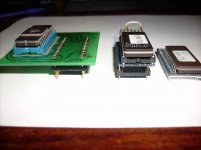dave_m
Veteran Member
Note that it replaces the ROMs AND the RAM...
Mike,
A question I have is it is necessary to remove existing RAM and ROM on the mainboard?
The picture of the system board using the expansion mod shows all devices removed. I hope this is not the case as it would involve a lot of work since my mainboard has most RAM and ROM soldered in.
Also it would not be as useful for troubleshooting mainboard memory problems.
If the existing memory can be left alone, I would be interested in buying a kit or populated board. My Data I/O can program the 16V8 GAL.
-Dave


